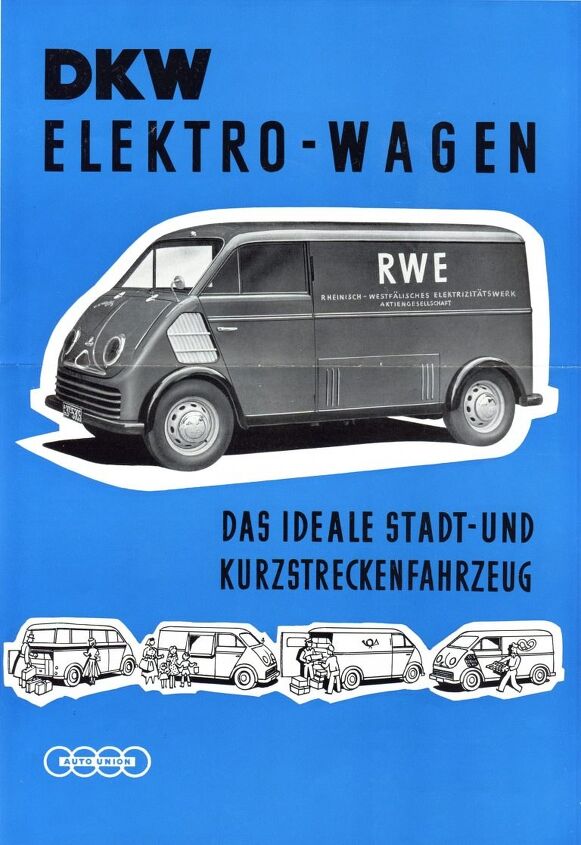Rare Rides: The Very Obscure DKW Schnellaster Elektro-Wagon

Recently Rare Rides featured a very clean example of the DKW Schnellaster van from 1956. The front-drive and transverse-engine layout of the Schnellaster previewed in the Forties the basic format of the family minivan that would arrive over three decades later.
Among the standard Schnellasters produced, there was an even rarer variant: An electric version, as DKW experimented with the possibilities of early EV tech.
The Schnellaster debuted in 1949, and remained in production through 1962 before complicated manufacturing and ownership issues occurred between Auto Union and Mercedes-Benz that ultimately ended the Schnellaster. But in the latter part of its production, Auto Union had some ideas about alternative propulsion methods for its very small van.
Though EVs were first created around the turn of the twentieth century (like by Detroit Electric), their general lack of power and considerable range issues kept them from becoming daily drivers for most consumers. But Auto Union thought there might be a different use case for use as municipal and delivery vehicles.
Said uses meant a vehicle didn’t need to travel far or very fast, details much more suited to then-current EV tech. In the latter part of 1955, Auto Union partnered with German battery maker VARTA (now a part of Rayovac and Johnson Controls) to develop an EV van. A 4.8-kilowat electric motor was installed at the front instead of the transverse two-stroke engine, and was attached to two lead-acid batteries good for a total of 80 volts and 200 ampere-hours. Top speed was just under 25 miles per hour, with a stated range of 50 to 62 miles – perfect for a day’s delivery work around town.
The first Schnellaster Elektro-Wagen was ready by spring of 1956, and debuted at the Hanover city fair. Auto Union found buyers for its special use EV vans, and built 100 in total through 1962. Most examples were used for delivery service, and purchased by power companies. The vans were largely used up and lost to time, and of the 100 produced just two remain in modern times.
One of them was located on an island along Germany’s north coast, Wangerooge. The island banned internal combustion cars long ago, so the Schnellaster EV found a long-term home there. Audi Tradition purchased and restored the van over several years, and debuted it back in 2015 as part of their heritage collection.
H/t to Jacob Brown at Audi PR for reaching out to offer materials and info on the Schnellaster EV.
[Images: Audi]

Interested in lots of cars and their various historical contexts. Started writing articles for TTAC in late 2016, when my first posts were QOTDs. From there I started a few new series like Rare Rides, Buy/Drive/Burn, Abandoned History, and most recently Rare Rides Icons. Operating from a home base in Cincinnati, Ohio, a relative auto journalist dead zone. Many of my articles are prompted by something I'll see on social media that sparks my interest and causes me to research. Finding articles and information from the early days of the internet and beyond that covers the little details lost to time: trim packages, color and wheel choices, interior fabrics. Beyond those, I'm fascinated by automotive industry experiments, both failures and successes. Lately I've taken an interest in AI, and generating "what if" type images for car models long dead. Reincarnating a modern Toyota Paseo, Lincoln Mark IX, or Isuzu Trooper through a text prompt is fun. Fun to post them on Twitter too, and watch people overreact. To that end, the social media I use most is Twitter, @CoreyLewis86. I also contribute pieces for Forbes Wheels and Forbes Home.
More by Corey Lewis
Latest Car Reviews
Read moreLatest Product Reviews
Read moreRecent Comments
- Namesakeone If I were the parent of a teenage daughter, I would want her in an H1 Hummer. It would be big enough to protect her in a crash, too big for her to afford the fuel (and thus keep her home), big enough to intimidate her in a parallel-parking situation (and thus keep her home), and the transmission tunnel would prevent backseat sex.If I were the parent of a teenage son, I would want him to have, for his first wheeled transportation...a ride-on lawnmower. For obvious reasons.
- ToolGuy If I were a teen under the tutelage of one of the B&B, I think it would make perfect sense to jump straight into one of those "forever cars"... see then I could drive it forever and not have to worry about ever replacing it. This plan seems flawless, doesn't it?
- Rover Sig A short cab pickup truck, F150 or C/K-1500 or Ram, preferably a 6 cyl. These have no room for more than one or two passengers (USAA stats show biggest factor in teenage accidents is a vehicle full of kids) and no back seat (common sense tells you what back seats are used for). In a full-size pickup truck, the inevitable teenage accident is more survivable. Second choice would be an old full-size car, but these have all but disappeared from the used car lots. The "cute small car" is a death trap.
- W Conrad Sure every technology has some environmental impact, but those stuck in fossil fuel land are just not seeing the future of EV's makes sense. Rather than making EV's even better, these automakers are sticking with what they know. It will mean their end.
- Add Lightness A simple to fix, strong, 3 pedal car that has been tenderized on every corner.







































Comments
Join the conversation
VERY Nice. Love it.
A perfect example of the wacky design typical of post-war Germany. Love it!